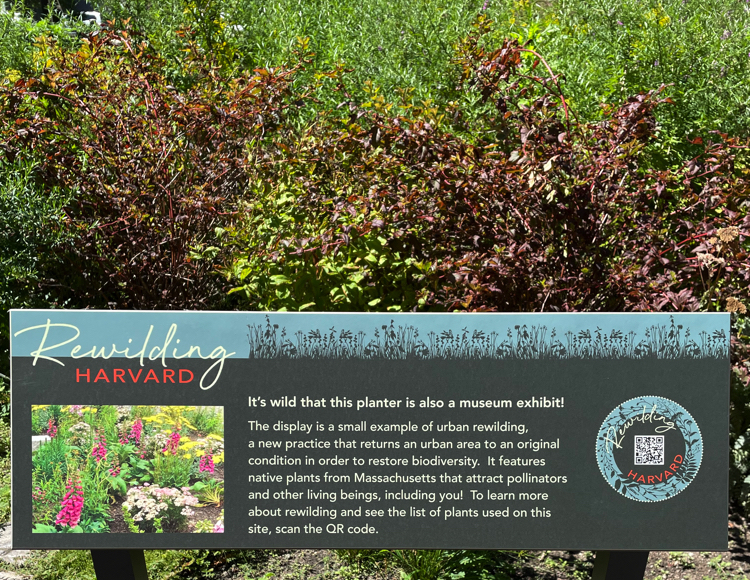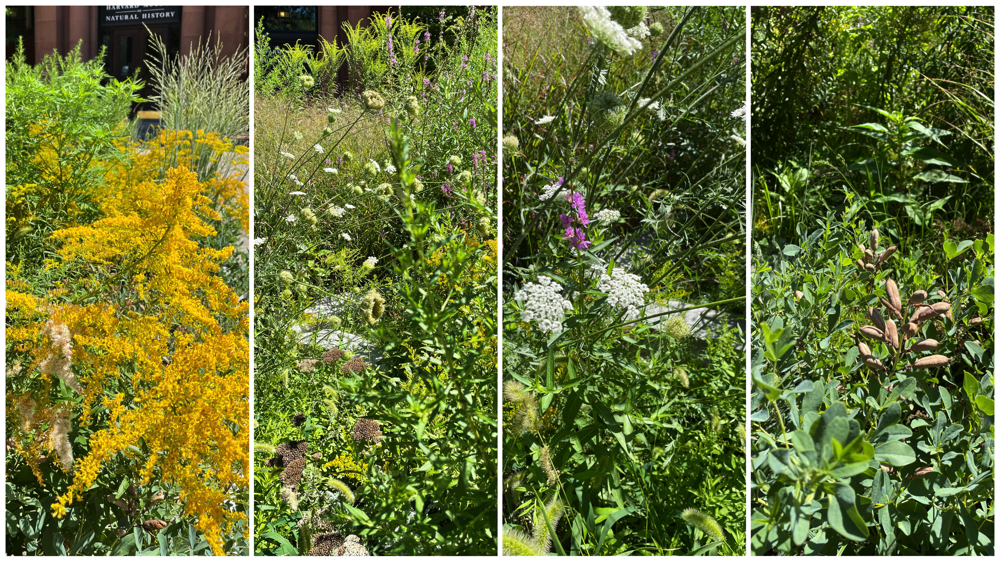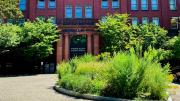You might not recognize the front of Harvard’s Museum of Natural History if you haven’t seen it recently. The manicured shrubs that used to occupy the museum’s front planter have been replaced by native species selected by the Rewilding Harvard Initiative.
The initiative, which began during the 2020-2021 academic year, includes a Harvard Graduate School of Design and Harvard history department course, SCI-6375B/History 1973, “Re-Wilding Harvard.” The course was open to both graduate and undergraduate students; those enrolled included a few GSD graduate students, a graduate student in anthropology, and undergraduates from a variety of concentrations.
The course was co-taught by Phillips professor of early American history Joyce Chaplin and assistant professor of landscape architecture David Moreno Mateos. Chaplin, who hopes to offer the course again, specializes in environmental history, the history of landscape and agriculture, and the range of ways that humans have interacted with the landscape throughout early American history. Mateos is a restoration ecologist interested in understanding the long-term recovery of ecosystems degraded by human development.

A placard at the museum-facing side of the planter explains the initiative and provides a QR code to the Re-wilding Harvard website.
Photograph by Kristina DeMichele/Harvard Magazine
“I've been on the board of the Harvard Museums of Science and Culture [HMSC] for a while, and I’ve had a long-term concern about the grounds at Harvard,” Chaplin said in a recent interview. “In terms of what Harvard is doing for the natural world, they’re very passive. Now I never walk over lawn without thinking there could be more clover, or Harvard could cut it less frequently so that insects are happier.”
Chaplin approached HMSC and also spoke with director of the Arnold Arboretum William “Ned” Friedman about the idea of bringing native plant species back to campus (see his feature on Arboretum specimens here). “I told Ned, ‘I don’t know whether this is the best moment to start.’ And he said, ‘C’mon, do it!’”
In the course, “Students researched landscape history at Harvard, the idea of rewilding,” she said, “and then specifically urban rewilding.” Many of the historical accounts of native species in New England described only some of the speciments present. “People writing these accounts were really describing things that could be useful to them,” Chaplin noted, “leaving everything else out.”

Some of the native species in bloom.
Photographs by Kristina DeMichele/Harvard Magazine; collage by Niko Yaitanes/Harvard Magazine
The lack of accuracy in written records was one challenge to the class’s rewilding efforts. Recent climate change, which can inhibit some native New England plant species, but also expand the range of southern species, was another. “Plants native to Virginia, for example” Chaplin said, “might survive better now in New England.”
After studying and compiling this research, students were asked to redesign the planter in front of the natural history museum to include species that attract pollinators and insects beneficial to the natural ecosystem. Some of the chosen species include Common ninebark (Physocarpus opulifolius), New Jersey Tea (Ceanothus americanus), Button Blazing Star (Liatris aspera), and Blue Wild Indigo (Baptisia australis).
From there, the student team worked with Harvard Campus Landscaping Services to figure out where each plant should be placed in the planter. “It’s good for students to realize that they were learning something, and they could claim a kind of expertise, but they also had to learn to respect what other people knew,” Chaplin emphasized.
Joint history and anthropology concentrator Katherine Enright ’23 said she is “used to diving deeply into environmental history texts and discussing them in a seminar setting.” But it was “novel and exciting to be able to translate that knowledge…to collaborate on a tangible product and make a change in Harvard’s built landscape.” Whenever she walks by the planter, the knowledge she most likes to share is “the identity of each of the 14 native species we selected for the planter outside the Harvard Museum of Natural History—which I happily point out to friends.”
Harvard landscaping services finished planting the rewilded plot in June 2021. Most of the plants came from pots, but some “had to be grown from seed (which can take as long as three to five years),” Chaplin pointed out as she gave a tour of the front planter. “There are two pieces of salvaged granite from an old building at Harvard. There are also stones from an old New England wall. These objects are symbols of how returning to an earlier state means undoing part of what the settler population reconfigured. And I like the idea that, even if Harvard were in ruins, all the plants and insects would survive.”
One interesting outcome of the initiative has been that other courses and fields have interacted with the rewilding site since its installation. Entomology students, for example, do some of their field work and observations there. “I’d love to know if the data show anything long term. How much more land would need to be rewilded,” she wondered, “before we notice that the insect population is really benefiting?”
As she finished her commentary on the rewilding site, Chaplin lit up as visitors stopped to read the information placard. “It’s awesome,” she said, to see that “right now, in this moment, people are reading the sign and interacting with this outdoor exhibit.”









